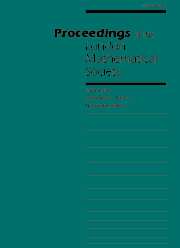Article contents
‘Good’ elements of finite coxetergroups and representations of Iwahori-Hecke algebras
Published online by Cambridge University Press: 01 March 1997
Abstract
Let $(W,S)$ be a finite Coxeter system and $B=B(W)$ the corresponding Artin-Tits braid group. The natural map $B \rightarrow W$ has a canonical section $r:W \rightarrow B$ defined by the condition that if $w \in W$ is written as a reduced expression in the generators in ~$S$ then $r(w)$ is the corresponding product taken in $B$. The main result of the present paper is as follows. Let $C$ be a conjugacy class in $W$ whose elements have order $d$ say. Then there exists an element $w \in C$ of minimal length in $C$ such that $r(w)^d$ is a product of terms of the form $r(w_I)^{d_I}$ where the following hold: $d_I$ is a non-negative even integer, $I$ runs over a sequence of subsets of $S$ which decreases (which implies that the terms commute), and $w_I$ is the longest element in the corresponding parabolic subgroup of $W$. Such an element will be called a ‘good’ element in $C$. The result is proved case by case, using the classification of irreducible finite Coxeter groups and the knowledge of representatives of minimal length from the article by Geck and Pfeiffer in Advances in Math. 102 (1993) 79-94.The main application of this result concerns the problem of calculating character values of Iwahori-Hecke algebras. The generic Iwahori-Hecke algebra $H$ associated with $(W,S)$ is a quotient of the group algebra of $B$ by the ideal generated by quadratic relations of the form $(s-q)(s+1)$ where $s \in S$ and $q$ is an indeterminate. Thus, $H$ is an algebra over a suitable field of rational functions in the variable ~$q$. The above result implies that if $w$ is a good element in the class $C$ of $W$, then the eigen values of the standard basis element $T_w$ of $H$ in an irreducible representation of $H$ are roots of unity times fractional powers of ~$q$, and the fractional powers occurring can be explicitly determined from the ordinary character table of $W$. This result is used to compute the character table of the Iwahori-Hecke algebra of type $E_8$. To determine the roots of unity, we use additional relations coming from the modular representation theory of ~$H$. This completes the program of determining the character tables of Iwahori-Hecke algebras.
1991 Mathematics Subject Classification: 20C20, 20F36.
- Type
- Research Article
- Information
- Copyright
- London Mathematical Society 1997
- 11
- Cited by


